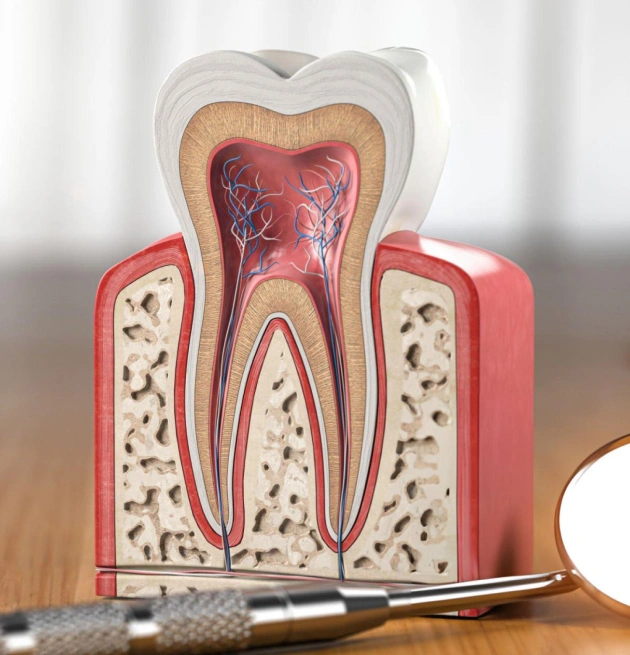
Reasons for Root Canal Therapy
Dentists and endodontists typically recommend root canal therapy for one of three reasons:
- Decay: When dental decay has progressed to the tooth pulp, which is the living tissue inside the tooth.
- Infection: If an infection occurs within the root, creating an abscess—visible as a dark halo on a dental x-ray—at the tip of the root.
- Injury or Trauma: Following an injury or trauma to the tooth.
To save the tooth, we remove the inflamed or infected dental pulp. The inflamed pulp consists of vital tissue that includes nerves, blood vessels, and cells, while the infected pulp is primarily non-vital tissue made up of bacteria. After thoroughly disinfecting the root canal space using various clinically proven methods, we fill it with biocompatible dental materials.
Root canal therapy is highly successful and can last a lifetime. However, it's essential to follow up with your primary dentist to properly restore the tooth, often with a filling or a crown.
Benefits of Root Canal Therapy
Root canal therapy effectively eliminates harmful bacteria from your tooth, healing infections, relieving pain, and improving your overall health. This procedure is necessary when decay or a crack has reached the nerve of the tooth.
Understanding Root Canal Retreatment
Causes of Root Canal Recontamination
The root canal space can become re-contaminated by bacteria from saliva, primarily due to:
- Improper Restoration: Failure to adequately restore the tooth after treatment.
- Leaking Fillings or Crowns: A filling or crown that develops leaks long after the initial treatment.
- Missed Canals: Canals that were overlooked during the initial treatment due to being too narrow or curved.
- Cracks in the Tooth or Root: Depending on the severity, a crack may render the tooth unsuitable for retreatment.
- New Decay: Fresh decay can expose the root canal filling material to bacteria.
- Incomplete Healing: A small percentage of root canals may not heal, requiring skilled evaluation by a clinician to determine if retreatment is necessary.
Root Canal Retreatment
Retreatment involves the following steps:
- Removal of Previous Packing Material: The existing filling material is taken out.
- Cleansing the Root Canals: The canals are thoroughly cleaned to remove any bacteria.
- Repacking the Tooth: The tooth is then repacked with fresh filling material.
- Possible Re-crowning: In some cases, a new crown may be necessary to restore the tooth.
What to Expect During Root Canal Retreatment
Root canal retreatment involves several key steps: removing the previous packing material, cleansing the root canals, repacking the tooth, and potentially re-crowning it. Essentially, root canal retreatment mirrors the original procedure, with the main difference being the removal of existing structural elements.
